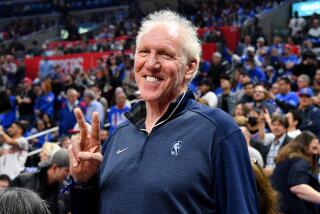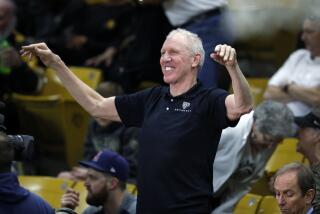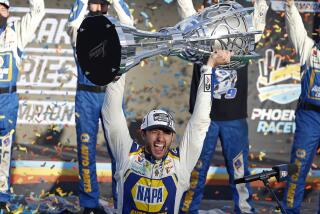Waltrip Evolves from Brash to Businessman
At first, he was Darrell the Brash, a fast-talking and somewhat boastful young charger, roundly booed but unwilling to go away.
Next came Darrell the Great, whose 1981-82 run through the NASCAR Winston Cup circuit produced 24 victories, a two-year total unmatched in the modern era of stock-car racing.
Then it was Darrell the Revered, a dedicated family man with a growing reputation for friendship to fans and fellow drivers. He became one of the most popular figures in the sport.
Now, there’s “Old D.W.,” the clown prince of racing, owner-driver, race analyst, car dealer, TV pitchman extraordinaire. Run right down to your local auto parts store for a fan belt, brake pads . . . you name it.
“I’d like to thank Western Auto . . . AC Delco . . . Havoline . . . Chevrolet . . . everybody,” precedes “Well, we had ‘em covered today” as his first obligation in Victory Lane.
Darrell Waltrip is no longer a race driver. Like an increasing number of his brethren, he’s a businessman who drives a race car, a man whose worth runs to eight figures, who learned his finances the hard way.
“I got into NASCAR racing because I thought I could do some things, make some money. I thought I had it all. I was outspoken, articulate, and I had a sense of humor.
“But I was an anti-establishment type. I saw some things I didn’t like in NASCAR, and had some things to say. I fought the wall, and the wall won.
“I had a great product, but I was a bad salesman.”
Racing fans once wore shirts reading “Anyboby but Waltrip.”
They didn’t see the other side of him. Once, he stood in the rain for three hours signing autographs at a department store. The next day he crashed, and the fans cheered.
“So I said those people should come see me at Kmart,” he recalled. “Well, it came out sounding like I was challenging them to come down to Kmart for a fight.”
Soon, he won so often and was so visible in the racing community that his message was delivered by others.
The late Neil Bonnett, a teammate during Waltrip’s dominance of the circuit, once spoke of a time he was 30 minutes late for a fan club function.
“When I got there they were having a great time,” Bonnett said. “Darrell came by and found out I was late and just stepped in talked to all the fans and took care of everything.”
Waltrip was the darling of the media from the start. Later, when he “became more conservative and learned to keep my mouth shut,” he was cast in the role of revered elder statesman of the track.
In 1989, when he ended 17 years of frustration by winning the Daytona 500, there was cheering in the press box.
Moments later, on national TV, he jumped around and carried on like a child who’d just received the pony he always wanted. He did the Icky Shuffle--badly.
Generally speaking, a new corn star was born.
Two years later, a new, albeit terribly unconventional, car owner came along.
Rain delays at races were like the breakaway segments in pro wrestling. Old D.W. would stop by, first as the stern-looking driver annoyed with the car owner. Then the hat went askew and out came the cheek in a suggestion it was filled with chewing tobacco. Naturally, the car owner was threatening to fire the driver. High drama stuff.
“Well,” he said with a laugh, “we have to wear a lot of hats in this business.”
Few wear as many as the 47-year-old Waltrip, who admits it has reduced his time with the race car.
“But this is not a sport,” he said. “It’s a business.”
And he’s treating it that way. A losing streak that has reached two years caused him to make changes in key spots on his team.
“We were so bad that I told them at the shop that if I was just a driver, if I didn’t own the car, I’d just park it,” he said.
Several strong showings since have given birth to subtle memories of Darrell the Great, winner of 84 races, three Winston Cup titles and more than $13 million in purses.
The latest occurred when Waltrip powered to the front Sunday in the SplitFire 500. A crowd of 94,000 was ecstatic.
“I had some people working for me who set me back a year and a half,” Waltrip said of fired crew chief Barry Dodson and engine builder Lou LaRosa.
“Did you ever hear of Pete Peterson?” Waltrip asked. “Did you ever hear of Claude Queen?”
Waltrip pulled them from oblivion to head his race team.
“They’ve given me a great car to drive,” he said of crew chief Peterson and engine builder Queen. “I can’t do all the things I could when I was 25. I can’t carry a bad car anymore. But you give me a good race car and I can still drive the wheels off it.”
More to Read
Go beyond the scoreboard
Get the latest on L.A.'s teams in the daily Sports Report newsletter.
You may occasionally receive promotional content from the Los Angeles Times.










